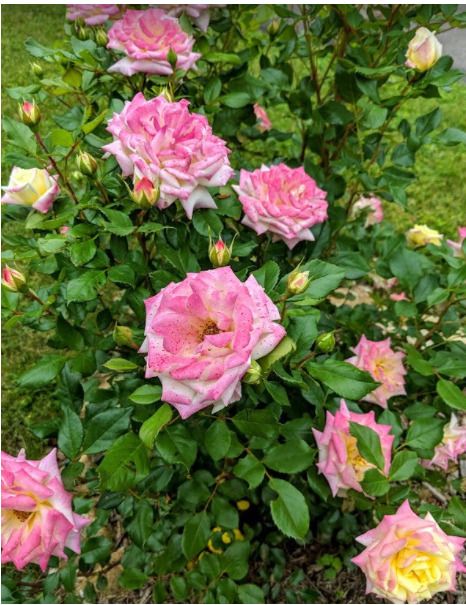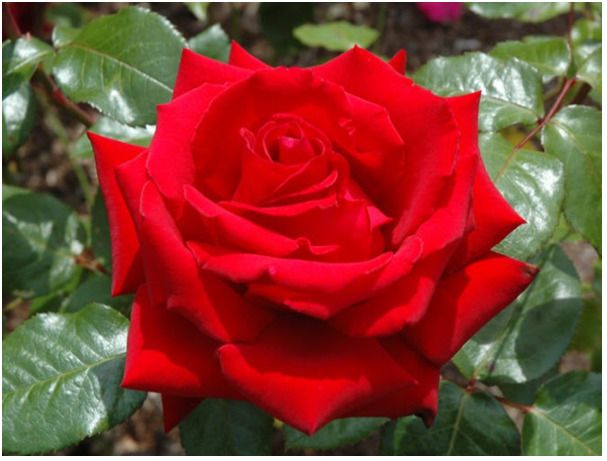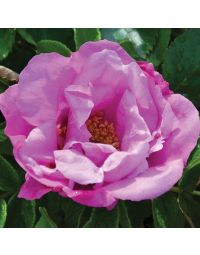Karen is Gertens staff rosarian. She has been with the company since 2017 and has been gardening for over 2 and a half decades. Her garden includes a wide variety of historical plants, water features, fountains, and over 60 varieties of roses. Her favorite gardening wisdom is: “Grow what you love!”. She clearly loves roses.

Oso Easy shrub rose ‘Double Red’
Most shrub roses form some size and color of rose hip. This is the fruit of the rose and some can be very ornamental. Rose hips can be used for potpourri, perfumes, and even as food.
Choosing your planting site
- Plant in 6 to 8 hours of full sun, ideally at least 2 ft. From salting and lawn fertilizing activity.
- Planting roses inside an edged bed or garden will keep away root competition from trees, weeds and large established shrubs.
- Choose a site away from Northwest winter winds. A sheltered site on a sunny southeast side of a building is ideal.
- Plant roses in mixed beds with good air flow.
- Roses appreciate chives, allium, marigolds, many herbs and scented geraniums, they help deter pests.
Planting
- Dig a hole slightly larger and deeper than the pot. If you have heavy clay soil, use a garden fork to scratch the sides of the hole which helps roots and water penetrate the soil.
- Mix your dug out soil with 1/3 more Gertens Green Loon compost (Not manure!). If you have heavy clay soil, use peat moss instead.
- Remove the rose from the pot and dust the roots with Green Loon mycorrhiza.
- Own root Minnesota hardy roses should be planted at the same level as they were in the pot.
- Grafted roses including all of Gerten's hybrid teas, grandifloras, and floribundas should be planted with the graft buried 3” under the soil.
- Measure and tie a ribbon on a cane to help.
- Place 2 cups of compost on top of the soil around the newly planted rose.
- Add 3 to 4 inches of Gertens Western Red Cedar mulch out to the drip line of your new rose shrub. In fact, preferably refreshing the whole garden bed! This aids your plants in many ways including moisture retention and some pest resistance.
- Water deeply. A soaker hose is ideal.
- Give them 3 years to “leap”!
Pruning and Deadheading
- Deadheading old blossoms should be done once the flowers begin to fade if the plant is a repeat bloomer.
- If rose hips are what you want, do not remove the blooms after mid-summer. Eventually, these will turn into fruit.
- Yearly pruning should be done in the spring. Cut out any dead or unwanted wood and shape the plant at this time. Never cut more than 1/3 of the plant at one time.
Winter Protection
- Minnesota hardy roses do not need much overwintering protection.
- Water them well in the Autumn and ensure there is a thick layer (3-4”) of mulch over the rose's roots when the temperatures begin to dip below freezing.
Own root roses are very resilient. Even if they lose considerable cane length from the winter, a healthy rose with well mulched roots will come back from base to bloom beautifully the next year.
Non hardy roses require more vigorous overwintering practices.
- Put roses and tree roses growing in pots in the garage when temperatures are reliably 40F or under.
- Don't forget to water pots lightly throughout the winter- or just add snow! Make sure snow is clean, not salted. Roses should come back outside slowly when temps are starting to reach high 40s or low 50s.
- For in ground protection, trim canes down to 18”, bury the rose in soil.
- Mulch and wrap with burlap or landscape fabric.
- A ventilated rose cone may be used if the rose is properly covered underneath the cone.
- If you have room at the planting site, you may also use the Minnesota Tip Method.
- Dig a low trench next to the rose, then lay the rose canes into the trench, covering the trench with soil and mulch.
Insects and Disease
Shrub roses are more resistant to insects and disease than their hybrid counterparts. No treatment is needed unless an insect or a fungus is spotted. It is best to space the plants out to decrease the incidence of fungus and make sure the plant is not under any undue stress.
Choosing The Best Rose For You:
Gertens offers many different classes of roses including: Rugosa, Hybrid Kordesii, Large Flowered Climbers, Miniature Roses, Minifloras, Polyanthas, Hybrid Teas, Floribundas, Grandifloras, and Shrub roses. If you are just starting with roses, be sure to look for roses that are hardy in your area, with long blooming times and can take some abuse. Most importantly- choose a variety that appeals to you personally! Here are some of our top recommendations:
Minnesota hardy own-root roses
- Rugosas- Extremely cold hardy to zone 3, and quick to wake up after winter. They have a long flowering cycle from late May/Early June usually until it starts to snow. Rugosas offer a fantastic rose and cinnamon or clove fragrance and have a beautiful autumn/winter hip display and some autumn color. They’re relatively disease-free, and their foliage stands up to Japanese Beetle pressure!
Our top recommendations in the Pavement series: Dwarf Pavement, Foxi Pavement, Snow Pavement and Purple Pavement.

Pavement rose ‘Snow’
- Petite Landscape Roses- This includes the Drift Series and most of the OSO Easy Series. These roses offer great color all growing season long. Some are awesomely fragrant! They are extremely low care- no need to dead head, just feed and go. They are very adaptable: awesome for planters, front of the bed, and near walkways. They take blazing western sun and reflected heat from stone, brick, or pavement. Because of their lower height, Japanese Beetles tend to leave them alone.
Our top recommendations in the Drift and OSO Easy series: Popcorn Drift, Pink Drift, OSO Easy Paprika, OSO East Hot Paprika, and OSO Easy Italian Ice.

Oso Easy ‘Hot Paprika’
- Easy Elegance- This series offers beautiful flower forms in a wide range of colors and fragrances. They are very disease resistant! Most will stay clean through the whole season. Easy to grow in zone 4, they offer the look of the fussier traditional exhibition class roses without so much work. The Easy Elegance series includes award-winning roses. Screaming Neon Red took home 4 of 7 awards at the 2017 Biltmore Trials including most outstanding and disease resistant.
Our top recommendations in the Easy Elegance series: Calypso, Champagne Wishes, Kashmir, Music Box, and Screaming Neon Red.

‘Music Box’
Top Recommendations for non-hardy roses
Hybrid Teas, Grandifloras and Floribunda roses are extremely popular with growers worldwide. Most varieties are not hardy here in Minnesota and can be challenging for first time growers.
- Try starting with varieties which are cane hardy in zone 4b-5b.
- Some modern varieties are more disease resistant, which can cut down on the amount of fungicide you have to use.
- Look for mention of disease resistance on the back side of the tag.
- Look for own-root roses here too. We do carry a few!
- Do you love it? Grow it! If you fall in love with a rose, then don't shy away from trying it in your garden.
- Be sure to provide these roses with proper overwintering protection via one of three methods: The Minnesota Tip, covering in ground roses fully with insulating mulch and hay, or bringing pots into the garage over the winter.
Our top recommended varieties for new growers who wish to try these roses include: Burst of Joy, Ingrid Bergman, Julia Child, Smokin' Hot, and Violet's Pride.

Hybrid tea rose ‘Ingrid Bergman’
Uses
Cut flowers and dried flowers. Rose hips attract birds, add winter interest, and are edible.

Explorer series ‘William Baffin’ rose. Hardy to zone 3. Photo courtesy of ask.extension.org
The experts at Gertens are always available to answer your questions!





